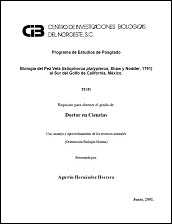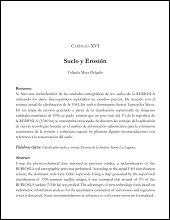Toxinas paralizantes en moluscos bivalvos durante una proliferación de Gymnodinium catenatum Graham en la Bahía de La Paz, México
Paralytic toxins in bivalve mollusks during a proliferation of Gymodinium catenatum Graham in Bahía de La Paz, Mexico
Autor
FRANCISCO EDUARDO HERNANDEZ SANDOVAL
DAVID JAVIER LOPEZ CORTES
CHRISTINE JOHANNA BAND SCHMIDT
Ismael Gárate-Lizárraga
ERICK JULIAN NUÑEZ VAZQUEZ
JOSE JESUS BUSTILLOS GUZMAN
Metadatos
Mostrar el registro completo del ítemResumen
"De febrero a marzo de 2007, se presentó una proliferación de Gymnodinium catenatum Graham en la Bahía de La Paz (México), con densidades de 6 x 105 a 2,39 x 106 cél. L-1. Durante este evento se determinó la concentración y el perfil de toxinas paralizantes en moluscos bivalvos (Pinna rugosa, Modiolus capax, Megapitaria squalida, Periglypta multicostata, Dosinia ponderosa y Megapitaria aurantiaca) y en muestras de fitoplancton. También se obtuvieron algunos parámetros físicos y químicos. Los valores promedios de la temperatura superficial y del oxígeno disuelto fueron de 20.9 ± 0.7 °C y 6.9 ± 0.3 mg L-1, respectivamente. Las concentraciones promedios de nitritos, nitratos, amonio, fosfatos y silicatos fueron de 0.22 ± 0.05, 1.04 ± 0.33, 0.89 ± 0.88, 0.81 ± 0.76 y 8.85 ± 1.60 µM, respectivamente. El contenido de toxinas paralizantes en las muestras de arrastres de red variaron de 4.32 a 79.60 ng saxitoxina equivalente filtro-1, identificándose 8 toxinas, siendo la C1 y C2 las dominantes. Las máximas concentraciones de toxinas paralizantes en los moluscos fueron de 31.14, 37.74 y 25.89 µg STXeq. 100 g-1 en M. capax, P. rugosa y M. aurantiaca, respectivamente. Se dan a conocer las variaciones en el perfil de toxinas paralizantes en las diversas especies de moluscos." "From February to March 2007 a harmful algae bloom of Gymnodinium catenatum Graham ocurred in Bahía de La Paz, Mexico, with cell densities from 6 x 105 to 2,39 x 106 cells L-1. During this event the toxin concentration and toxin profile of paralytic shellfish toxins in mollusks (Pinna rugosa, Modiolus capax, Megapitaria squalida, Periglypta multicostata, Dosinia ponderosa, and Megapitaria aurantiaca), and in phytoplankton samples were determined. Some physicochemical data were obtained. The average values of the surface temperature and dissolved oxygen were 20.9 ± 0.7 °C and 6.9 ± 0.3 mg L-1. The average concentrations of nitrites, nitrates, ammonium, phosphates, and silicates were 0.22 ± 0.05, 1.04 ± 0.33, 0.89 ± 0.88, 0.81 ± 0.76, and 8.85 ± 1.60 µM, respectively. The concentration of paralytic shellfish toxins in the net phytoplankton samples varied from 4.32 to 79.60 ng saxitoxin equivalents filter-1, identifying 8 toxins, the most abundant being C1 and C2. The highest toxin concentration found in mollusks were 31.14, 37.74, and 25.89 µg STXeq 100 g-1 in M. capax, P. rugosa, and M. aurantiaca, respectively. The variations in the paralytic toxin profile in the different mollusks species are given."
Colecciones
Ítems relacionados
Mostrando ítems relacionados por Título, autor o materia.
-
PROMOCIÓN DEL PERIFITON PARA EL CULTIVO DE CAMARÓN BLANCO: HACIA UNA ACUICULTURA ECOLÓGICA
DOMENICO VOLTOLINA LOBINA; JUAN MANUEL AUDELO NARANJO; MARIA DEL ROSARIO PACHECO MARGES -
Suelo y Erosión
YOLANDA LOURDES MAYA DELGADO


